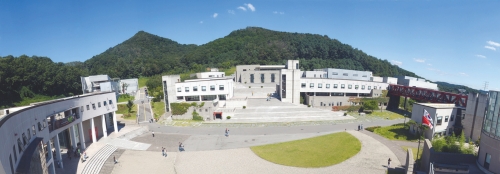
Shin Kyung-sook, the nation's best-selling novelist. Jeon Do-yeon, best actress at the Cannes International Film Festival. Yu Jae-seok, Korea's most sought after TV celebrity.
What do these famous cultural figures have in common They studied at the same school -- Seoul Institute of the Arts -- although their spheres of activities vary widely. And that comes as small surprise for people who know the past and present of the nation's top art college.
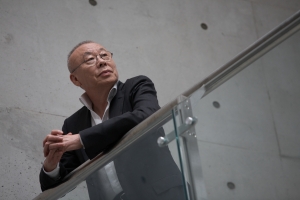
Founded by the late playwright and director Yoo Chi-jin at the foot of Namsan, Seoul, in 1962, this institute has grown to be the nation’s top art academy, and has turned out numerous stars in drama, movie industry, literature, design and music. So much so that graduates of Seoul Institute of the Arts have formed a school of their own, not just in entertainment but in various sectors of culture and arts.
“On the basis of Korean people’s artistic spirit and their traditional arts, we are seeking both national identity and global universality to create and promote world-class culture and arts,” said Yoo Duk-hyung, president of Seoul Institute of the Arts (SeoulArts), summing up the school’s educational ideals.
To realize the ideals, Yoo said in an interview with The Korea IT Times, his institute seeks four major principles as its future vision:
- Creation of world-class environment for education and creation
- Education based on connection, circulation and integration
- Cooperation between arts and industry
- Grafting of arts and technology.
‘Global Hub’ project
Nothing illustrates the institute’s globalizing ambition better than its “Global Hub” project.
“This project calls for setting up and operating of 'SeoulArts Global Hubs' in major strongholds of culture and arts all over the world, through which we exchange the contents and techniques of Korea’s unique culture and arts with those of the world,” Yoo said. “Through this process, we can develop creative themes and subjects and cultivate human resources to globalize our institute and strengthen its educational competitiveness.”
The most active example is “Global Hub New York,” which is situated in the world’s culture capital. Last year, the institute set up its cultural base camp at La Mama Experimental Theater, one of the most avant-garde arts groups in America. Almost all high-tech teaching is possible there, including video lecturing and conferencing as well as tele-workshop, tele-performance and tele-presentation.
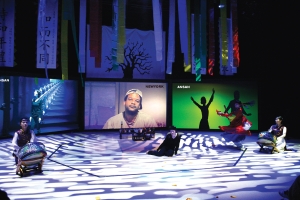
As seen above, playing the biggest role in accelerating the Global Hub project is the “tele-presence” system. For this, the institute has built long-distance virtual studios at Great Jones Studio at La Mama and a high-tech studio at its Art & Technology Center (ATEC) in the Ansan Campus, Gyeonggi Province. “We then linked them together by using the tele-presence technology, enhancing the audiovisual sense of presence transcending the long distance and opening wider the door to international cooperation for state-of-the-art education and creation in various areas, including lecturing, performance, media arts and design,” the 72-year-old artist-cum-educator said.
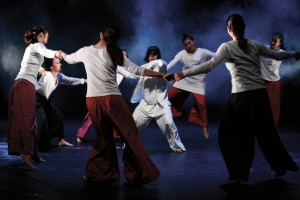
Never to be omitted in talking about the institute’s international exchange programs is the “SeoulArts-Chapman University Joint Filmmaking Project.” Under the motive of “Film is an international language,” this project calls for selecting students from the two institutions and letting them visit each other to make films in a foreign land and under a different culture from theirs. There were previews of two films made by this formula – “Forbidden Play” (by SeoulArts students) and “Ordinary Strangers” (by Chapman students) – last year. This year, students of the two schools are jointly making a film titled “Amerea” (America + Korea).
Go West
Now, the Global Hub project is going beyond the U.S. East to reach the West states, spearheaded by the successful launch of the "Global Hub LA."
The institute has already signed an MOU with tvK, a Korean broadcasting station in Los Angeles, and Brooks College, and is conducting brisk discussion with the California Institute of the Arts (CalArts) and California State University (CSUN), Northridge. "We are seeking ways of jointly introducing CalArts' famous lectures, such as 'Percussion' (Prof. Dave Johnson) and 'Rules and Space' (Prof. Sarah Roberts)," Yoo said. "CSUN has also proposed a joint work in the product/packaging design project using tele-presence equipment through the educational corporation of Viscom under the initiative of Prof. Dave Moon."
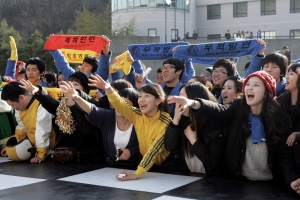
Certainly, the institute's network of educational cooperation abroad is not limited to earlier-mentioned American schools. Among its closest foreign partners are Pratt Institute, Long Island University, Art Center College of Design, Buena Vista University (U.S.); Ravensbourne College of Design and Communication (U.K.); Victorian College of the Arts, Sydney College of the Arts, UNSW, Royal Melbourne Institute of Tech, School of Audio and Engineering (Australia); Musashino Art University, Kyoto University of Art and Design, Tohoku University of Art and Design (Japan); NYU Shanghai, the National Academy of Chinese Theater Arts (China); and Lasalle-Sia College (Singapore).
Such a vast global network of partnerships would lose its luster without the corresponding ability and efforts to produce top-quality contents, a job currently led by the institute's Art & Creation Center (ACC).
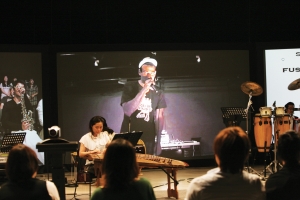
"In a nutshell, the ACC is our institute's heart of creation activities, or a conductor, which orchestrates all of its creative works and activities through coordinating cooperation among its various departments engaged in drama, music, dance and media arts as well as connecting the school to theaters and the rest of society," the SeoulArts head said.
High on ACC's work schedule for 2010 includes the "Young Production" project, which selects two student performance teams a year and provides financial and other supports; "After the day"project, a culture-sharing performance tour; and support project for "The Han River Flows,"ACC's most ambitious production this year to be staged in cooperation with Dongnang Arts Company, an art troupe affiliated with the institute.
Future blueprint
Since its foundation 48 years ago, Seoul Institute of the Arts has served as the birthplace of Korea's young artists, providing them with skills and creativity to compete on global stages.
For nearly half a century, the institute has strived to become the nation's top art school. One of the most noticeable accomplishments of the incumbent president of the institute is the dual campus system, in which its Namsan headquarters serves as the hub for presentation and performance while its Ansan Campus provides the students with space for academic learning and experimentation of up-to-the-second artistic trends by making the most of top-level facilities and environment. "It's like most prestigious medical schools also run large university hospitals," Yoo said.
In 2008, it also introduced the four-year bachelor degree program for students wanting to intensify their major, a move aimed at another take-off by lifting its academic reputation, he said.
The institute will meet its 50th founding anniversary in two years, an occasion for the restoration of intense artistic spirits and better communication with society through education and creation.
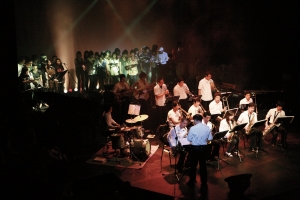
To this end, President Yoo said, the institute will continue to produce world-class contents through linking, circulating and integrating the relationship between ACC and ATEC like that of medical school and university hospital.
"We will also accelerate the grafting of arts to high technology, at times by converging them and having them collide with each other to seek new methodology and find innovative paradigms," Yoo said.
Instead of remaining within the ivory tower, the institute will actively cooperate with both foreign counterparts and the domestic industries to give the hard-won artistic creativity back to society through educational collaboration.
"All this will eventually lead to the realization of public good through the means of culture and arts, because the goals of creation is to upgrade the quality of life by enriching the increasingly dreary society and providing emotional satisfaction to the public," Yoo said.
Given the institute has achieved over the past half century, Koreans can be assured that it would emerge as a world-renowned art academy in the next 50 years.


